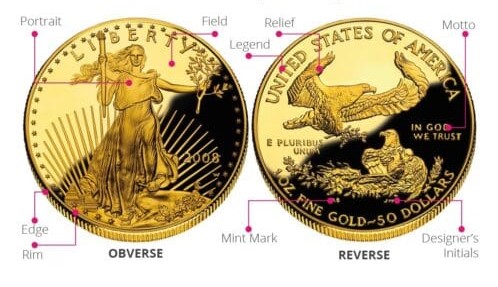| BULLION | Ingots, coins, or other issues that trade for their intrinsic metal value. Precious metals (silver, gold, platinum, and palladium) are included as bullion. |
| BULLION COIN | A legal tender coin that trades at a slight premium to its value as plain metal. |
| BURNISHING | A process in which the surfaces of a coin or a planchet are shined through rubbing or polishing. This term has both a positive and a negative context: In a positive sense, Proof planchets are burnished before they are struck. The procedure was done originally by rubbing wet sand across the surfaces to impart a mirror-like finish in a negative sense, the surfaces on repaired or altered coins may be burnished by mechanical or chemical methods. For example, a high-speed drill with a wire brush attachment is used to achieve this effect. |
| CAMEO | A proof, or prooflike coin with exceptional contrast between the fields and the devices. On a cameo coin, the fields are mirrorlike, while the devices give a frosty appearance. |
| DEEP CAMEO | Term applied to coins, usually Proofs and prooflike coins that have deeply frosted devices and lettering that contrast with the mirror fields. |
| DIE | A steel rod that is engraved, punched or hubbed with the date, lettering, devices, and other emblems used to strike a coin. |
| GRADE | The numerical or adjectival condition of a coin |
| HIGH RELIEF | A coin with deep concave fields, due to its design. High relief coins required extra pressure to be fully struck, and were difficult so stack. Therefore, the few coins struck in high relief by the U.S. Mint (such as the 1921 Peace dollar and the 1907 Roman Numeral double eagle) were each made for only one year. |
| MINT STATE | Describes a coin that has never been in circulation. Thus, the coin has no wear. A mint state coin may still be weakly struck, and therefore lack the detail of even a lower grade coin. All mint state coins have some imperfections if you study them hard enough. The term “Mint State” may also correctly be applied to coins that were struck as proofs. Marked as MS |
| MINTAGE | The number of coins of a particular date struck at a given mint during a specific year. |
| MINTMARK | Letter(s) stamped into a coin to denote the mint at which it was struck. |
| NGC | Acronym for Numismatic Guaranty Corporation, located in Parsippany, NJ. Currently the leading coin grading service. |
| NUMISMATICS | The science of money. Coins, currency, tokens, inscribed bars, and all related items are numismatic. |
| PCGS | Professional Coin Grading Service, a leading third-party coin grading service located in Newport Beach, California. |
| PLANCHET | The blank metal disk, which becomes a coin when struck under high pressure between two dies. |
| PROOF | The term Proof denotes a method of manufacture, not a grade. Proof coins are made with special care, exclusively for collectors or investors and not struck for general circulation. Generally, proof coins are struck on specially selected and polished planchets. They are struck using polished dies. Usually the coins are made on a slower moving press, and/or are struck more than once. Most proof coins are brilliant, with a mirrorlike surface. |
| SEMI-NUMISMATIC | Refers to a coin that has a significant bullion value and some numismatic value. |
| SPOT PRICE | Current market price at which an asset is bought or sold for immediate payment and delivery. |
![]() $
0.00
$
0.00
![]() $
0.00
$
0.00
![]() $
0.00
$
0.00
![]() $
0.00
$
0.00




